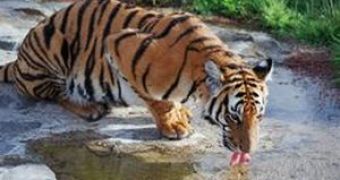Last year, the South China Tiger, also known as Amoy tiger (Panthera tigris amoyensis), a subspecies native of south China, was catalogued as the fourth race of tiger extinct in the wild in just 100 years. The last one was seen in the wild in 1964. In 1994, the last known wild South Chinese tiger was shot by poachers in the Hunan province.
The Amoy tiger is considered to be the most primitive tiger, it originated 2 million years ago, and other forms evolved from it. It is considered China's second most important conservation species (the first being the giant panda), but in 2000 there were only 62 South China tigers living in captivity in China, and very few in the wild, compared to the giant panda, with a population of 3,000.
Now, the only place they can be found in the wild is ...South Africa. In the dry savanna, very different from its wet subtropical forests, a new hope lies for saving this subspecies. On November 23, Cathay, a female South Chinese tiger, gave birth to the first cub of this subspecies outside of China, the first product of an ambitious and much-criticized project.
"This is definitely their last chance. We are attempting something that has never been done. We're taking a gamble. It might still not succeed but at least we have tried," Li Quan, former fashion model and founder of the Save China's Tiger's organization,who transported the rare specimens from China to South Africa, told AFP.
Quan bought 17 former sheep farms in the Free State province, setting up a reserve where she is reintroducing captive tigers into the wild, teaching them how to hunt.
Conservationists say that the project is an expensive waste of time, though Quan states it's important both for the tiger's survival and for China.
"People don't know wildlife reserves. How can you expect people to want to help wildlife if they can't even see them," she said. "The tiger could do for conservation in China what the "Big Five" did in South Africa, using the term once used by hunters for five of Africa's greatest wild animals -- the lion, leopard, elephant, buffalo and rhino -- today a national "signature" and major tourism draw. Critics just don't understand the goal is not just to save a few endangered tigers but to save a Chinese culture symbol," said Quan, a native of the Chinese sign of the tiger. The project is a "tremendous expenditure when there are so many other priorities for tiger conservation in China. Functionally, the South China tiger is virtually extinct. This isn't going to bring it back", Sue Lieberman, director of the Global Species Programme of the World Wide Fund for Nature (WWF) wrote in "The Sunday Telegraph".
Lieberman believes that the race's genes have deteriorated due to inbreeding, caused by the low number of individuals and this menaces South Africa's bio-diversity; and also, she signals that the dry Free State is in the same habitat with the wet south China. But since the project's launch in 2003, at the Laohu Valley Reserve, 33,000-hectare (81,000-acre) large, four zoo-born tigers have been taught to hunt and now are thriving in the grasslands.
"Yes they are an exotic species, but so are cattle who do more damage to indigenous wildlife than a tiger. The tigers do not compete for game with South African animals. We have to introduce prey. What game was here? These were sheep farms." said Quan.
She wishes that in about 15 years, a new generation of cubs could be re-introduced into the wild in China. Quan and her husband have spent $ 8 million (5.4 million euros) for the South African reserve, but extra 20 million more are required for the two Chinese sites. If the Chinese experiment fails, Quan thinks it would be worth keeping the tigers on the Laohu, with all the opposition involved.
At the beginning of the 1900, China's forests harbored 40,000 South Chinese tigers. 50 years ago, the population of the South Chinese tiger summed a relatively healthy number of 4,000, but when Mao Tse-Tung came to power, he declared this tiger to be a pest, while the Amur (Siberian) tiger was declared a protected subspecies. Following this law, South Chinese tigers were hunted to the brink of extinction, with over 3,000 tiger skins being handed in during the late 1950s and 1960s. By 1982, wild populations were estimated at a slim 150 - 250 animals, at six years after Mao's death, and "Save the Tiger Program" was introduced.
"The first 50 years was war and chaos and the next 50 years was habitat destruction and modernization," said Quan. The South Chinese tiger was also affected by poisoning, pollution from chemical fertilizers, loss of habitat, and reduction in the number of prey animals. The sub-tropical evergreen areas, favored by the South Chinese tiger, are now very fragmented with most no larger than 500 square kilometers.
Qiu Yunxing, director of the Meihuashan Nature Reserve Administration, said that a 460 hectare park in east China's Fujian Province has been completed for the rare animal to get used to life in the wild. With virgin forests, man-made lakes containing spring water, meadows and other vegetation, the park borders the 20,000 hectare subtropical Meihuashan Nature Reserve in Longyan City of Fujian. The reserve is considered to be the best natural habitat for South China tigers, because of its favorable climate and sufficient rainfalls, its high-quality grassland and wildlife.

 14 DAY TRIAL //
14 DAY TRIAL //